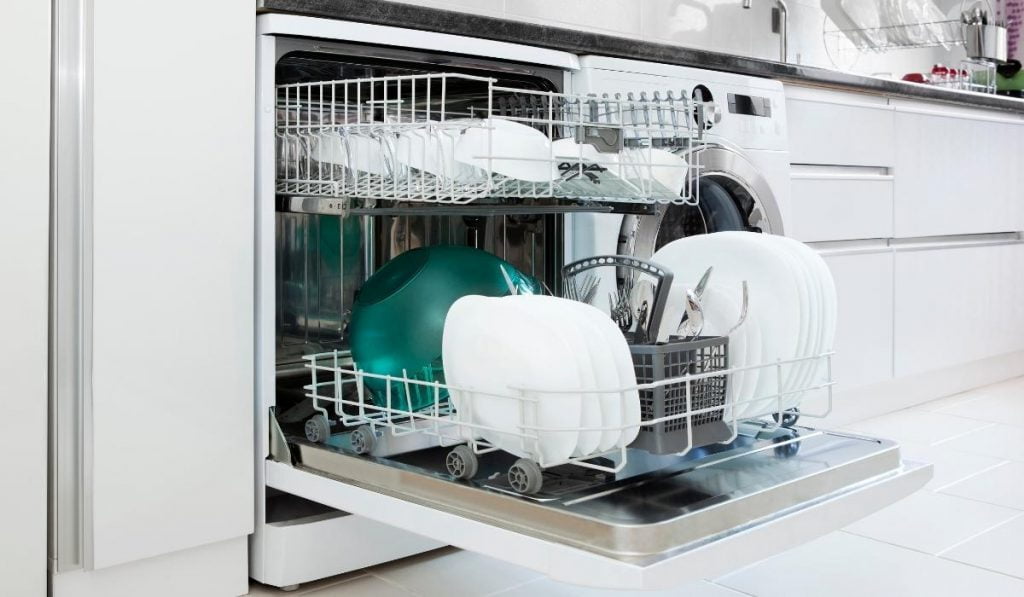When dishes are dirty, we know where to place them into the dishwasher machine. It does a great job cleaning dishes and many kitchen cutlery. However, not many know about how such a great invention came to be and how the idea came about. Who invented the dishwasher?
The first mechanical hand crank dishwasher was invented by Joel Houghton in 1850. However, the first successful modern day dish washer was invented in 1883 by Josephine Cochran. Cochran’s dishwasher, unlike Houghton’s, used pressurized hot water instead of scrubbers and was granted a patent for it in December 1886.

This article explores who invented the dishwasher. It will also look at several things, such as why dishwashers were invented and what the earlier dishwashers were like, before Cochcran’s invention.
Why Were Dishwashers Invented?
Dishwashers were invented to automate cleaning dishware, cookware, and cutlery. This may be important when many wares are used and cleaned daily, such as in restaurants or hotels. Dishwashers also minimize the damage to the wares from manual washing, such as chipping or breakage.
Dishwashers were invented and became popular for several reasons. First, it allows the washing of a large number of wares. It also protects the wares from damage as they are not being handled manually. Finally, dishwashers can be used to dry wares.
Automates Dishwashing Process
Dishwashers were invented and used extensively because they automate the tedious job of clearing dishware, cookware, and cutlery.
In commercial settings where many wares are cleaned, dishwashers are particularly well appreciated. Hotels, restaurants, and mess halls are known to rely on dishwashers. At home, dishwashers free up the time spent on cleaning wares, as well as saving water.

Protects The Wares
One of the biggest risks when cleaning dishes manually is breakage. This is because china, in many ways, is a fragile object, and clearing china and wares manually often involves scrubbing.
On top of that, with detergent, the china’s surface becomes slippery, increasing the chance of slippage. The china may also knock on the sink or each other, causing chipping.
When using a dishwasher, the risks of breakage or chipping become less likely, since the china simply sits on the tray. At the same time, the machine sprays hot water and detergent to clean it.
Faster Drying
Manual dishwashing usually dries their wares by dripping or wiping them with a dry cloth. After that, the wares are placed on their racks. This further increases the workload and time needed to clean the wares.
A dishwasher solves the problem by drying the wares after washing them inside the machine. Once dried, the racks inside the dishwasher can function as a dish rack, holding onto the wares before they are used. This saves up a good amount of time.
How Were Dishwashers Invented?
The dishwasher took several iterations and attempts before the modern dishwasher came to be. The earlier dishwashers still rely on scrubbing and may need manual operation, as they are not electrically powered. It took until Josephine Cochcran to develop a good dishwasher that we may recognize today in 1886.
Inventions usually do not happen suddenly and in isolation. Before the invention came to be, earlier inventions were created to deal with the issue. The inventions were then improved until the proper solution arrived.
You can assume the same with dishwashers. There were two notable dishwashers invented before Mrs. Cochran’s. Although they were not as successful, they paved the way and perhaps inspired modern dishwashers.
Joel Hughton
Joel Houghton was the first person to undertake the task of automating dishwashing. In 1850, he designed a manual dishwasher. His invention is a large wooden box that splashes water on dirty dishes.
The splashing motion is operated with a manual, hand-turned wheel. The machine also had scrubbers. Joel patented the design, which may have worked in the days when electricity was not yet discovered.
L.A. Alexander
L.A. Alexander did not invent his version of the dishwasher out of the blue but took Houghton’s idea and developed it further. Rather than spraying water on the dishes, L A Alexander tries to see if he can move the wares instead.
In 1860, he added a mechanism that allowed users to spin a rack of dishes through a tub of water. This means you load your dirty dishes onto a rack, fill the machine with water and soap, and then manually turn the rack to run it through the soapy water instead.
Not a bad idea, especially in pre-electricity days. But it took Josephine Cochran to get the job done.

Who Invented The Dishwasher?
The invention of the modern dishwasher is credited to Josephine Cochchran of Shelbyville, Indiana, US. In 1886, she received a patent for the dishwasher, developed with the help of her family members, who are mechanics and business owners.
In 1858, Josephine married a wealthy merchant, William Cochran. As a result, she needed to start hosting dinner parties and events, which meant she had a lot of dishes to clean.
In those days, she had servants in her house, which meant she could get help with the cleaning. However, she noticed her servants were not careful with her china while cleaning.
As the parties go on, she can observe more and more chips and breakages on her china. It doesn’t help that the china she was using was heirloom china from her family. She thought there may be a better way to manage the issue, which sparked her idea to create a dishwashing machine.
At first, the design work was difficult, as she was not trained as an engineer or a mechanic. She roped in George Butters, a local mechanic. They went ahead and measured the sizes of plates, cups, and other wares and designed wire racks to hold and separate them.
They then put a compartment at the bottom of the machine to hold soap. The compartments were placed inside a flat wheel. A copper boiler helps to heat up water.
They then added a motor, which is used to power the wheel. As the wheel turns, the water becomes bubbles and soapy. The soapy water is then squirted onto the dishes to clean them.
The design was patented in 1886 in her name. She later founded the Cochran dishwasher company and displayed the machine at the 1893 Chicago World Fair. From there, her business continued to grow to the point that she opened a factory near Chicago.
It took until the 1950s before dishwashers were cheap and popular enough to be used in many American homes. Modern dishwashers retained many of her designs and have remained popular in American homes.
Her company eventually survives as part of KitchenAid, and today, her legacy is a part of Whirlpool. If your dishwasher is from Whirlpool, you also own a piece of historical legacy from Mrs. Cochran herself.
How Have Modern Dishwashers Evolved?
Modern dishwashers have taken Cochran’s design and improved it. Added functions include wash cycles, removable racks, controllable sprays, and adjustable water temperature. There are also technologies such as dish drying and special washing detergents that remove water stains.
Since Josephine Cochran invented the dishwasher, the machine has undergone many improvements.
Most of the changes stem from the improvement of technology. During her time, electricity was considered revolutionary, and things such as plastics, synthetic rubber, plastics, integrated circuits, and computer chips did not exist.
Subsequent dishwasher makers leveraged these technologies and introduced many functions that made modern dishwashers even better than Josephine Cochran’s invention.
However, the base technology and concept remain the same, such as the wired dish rack and spraying of water and detergent to wash the dishes.
Wash Cycles
Mrs. Cochran’s design likely only sprays water and detergent on the dishes. Then, the water is replaced to rinse the wares. With modern dishwashers, you can set up wash cycles.
The modern dishwasher can pre-wash by spraying away stains before washing the dishes with detergent. Then it rinses the dishes again with water. These are all done automatically.
Removable Racks
Mrs. Cochran’s invention likely does not allow the racks to be movable. This makes loading and unloading the dishes into the racks slightly more troublesome. Modern dishwashers come with dish racks that can slide in and out. You can also remove it completely to clean it.
Spray Controllers
Mrs. Cochran’s dishwasher uses a motor to power the spray and may not have options to control how strong the spray is. Modern dishwashers allow you to set the spray’s strength to avoid damaging your dishes.
Adjustable Water Temperature
Mrs. Cochran’s invention uses a copper boiler to heat the water. There is hot water, but there may not be a way to control how hot the water is. With a modern dishwasher, you can easily control this, allowing you to wash more delicate dishes and wares.
Dish Drying
Mrs. Cochran’s dishwasher only washes but does not dry the dishes. This means you must take out the dishes and wipe them. Modern dishwashers usually come with ways to dry the dishes, such as by blowing hot air.
Special Dishwashing Detergent
Older dishwashers may leave water stains on the dishes, especially if the water used is harder. Modern dishwashers can eliminate that with the help of specific detergents that remove water stains.

